Bonds occupy a pivotal spot in countless investors’ portfolios. While stocks may promise high returns amid growth spurts, bonds often provide the stability and predictable income that can soothe anxieties when markets grow turbulent. Among the diverse options out there, one particular offering stands out for its broad coverage and reputable management: the Vanguard Total Bond Market ETF (BND).

Why has BND garnered so much attention? In essence, it gives you near-complete exposure to the U.S. investment-grade bond market. That means it doesn’t specialize in any single type of debt or chase high-risk, high-yield territory. Instead, it spans government bonds, mortgage-backed securities, and corporate bonds with solid credit ratings. The logic is straightforward: if you’re aiming for a core bond position to anchor your portfolio, BND can bundle these categories into a single ticker, simplifying your life while keeping costs extremely low.
But what precisely is BND? How is it constructed, and why should you care about that construction? What are its strengths and weaknesses, and how has it performed across different market environments, from times of stable interest rates to periods of rising inflation? For that matter, who should consider buying it, and what types of investors might be better served by a different approach to fixed-income investing? These are the questions that spring up when you spot BND on your brokerage’s list of potential bond ETFs.
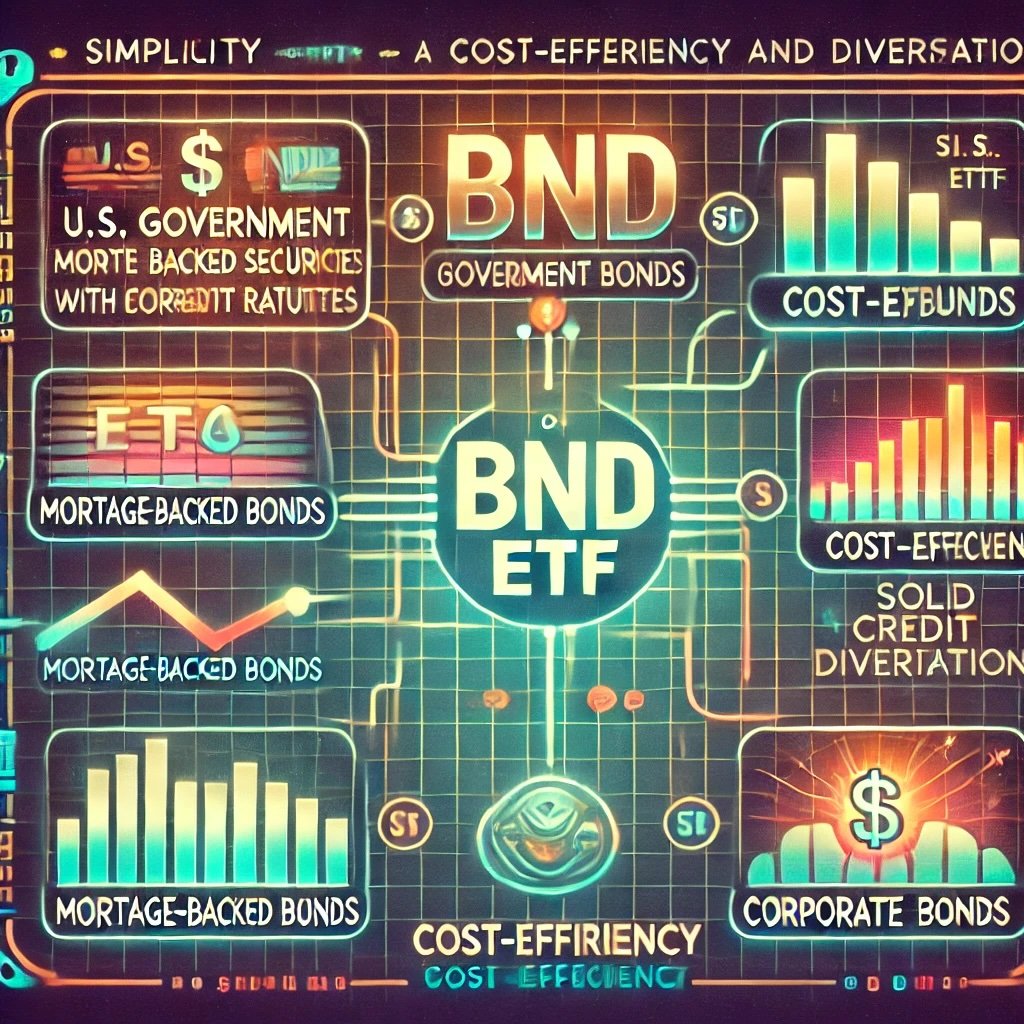
We’ll attempt to examine all these angles, starting with a quick rundown of BND’s basic attributes—like expense ratio, inception date, and underlying index—before moving on to the nitty-gritty of its portfolio composition. We’ll take a look at what proportion is allocated to U.S. Treasuries vs. corporate bonds vs. government-backed mortgage securities, and how that combination influences both its yield and risk. Then we’ll shift to historical performance, checking how BND stands up under different economic conditions: from the financial crisis of 2008 through more recent times of shifting interest rates.
But performance alone doesn’t tell the full story, which is why we’ll also delve into the deeper reasons BND might make sense in a balanced portfolio. We’ll highlight its broad diversification, cost efficiency, and certain structural traits that can make it more attractive than a narrower or pricier bond fund. Of course, we’ll be candid about the limitations as well—like its modest yield in a low-interest-rate environment, or the potential interest rate sensitivity that can erode returns if rates spike quickly.
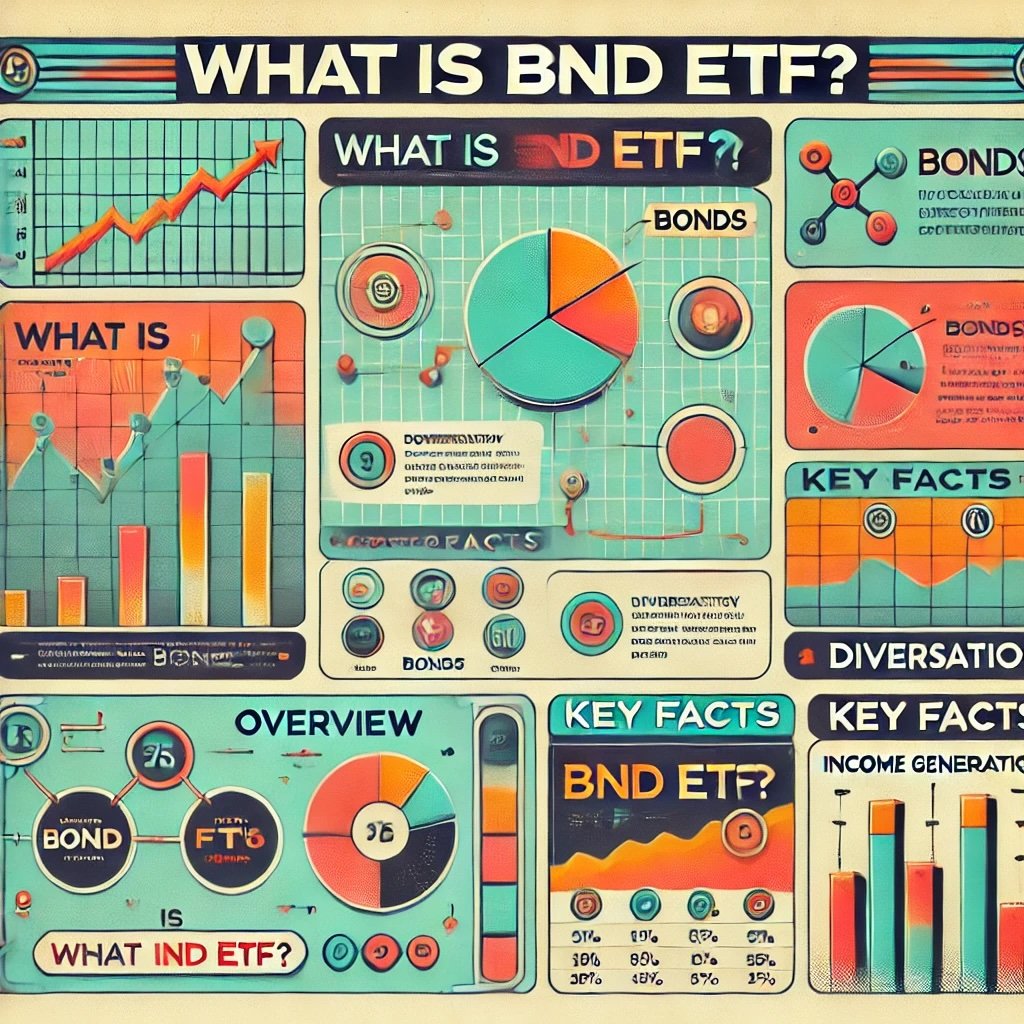
What Is BND ETF?
Overview of the ETF
The Vanguard Total Bond Market ETF (BND) is an exchange-traded fund designed to mirror the performance of the overall U.S. investment-grade bond market. It does so by following a well-known bond index, which we’ll explore in a moment. The ETF is managed by Vanguard, a company celebrated for pioneering index investing, championing minimal fees, and pushing for transparency in an industry often bogged down by complexity.
With BND, your objective is to hold a single ETF that delivers exposure to a broad array of bonds—government, corporate, and mortgage-backed securities—without having to meticulously pick individual issues or juggle multiple specialized bond funds. This streamlined approach resonates strongly with individuals seeking a “core” fixed-income holding. Instead of purchasing separate funds for Treasuries or corporate credit, BND aggregates it all into one package.
Key Facts
- Inception Date: BND began trading on the NYSE Arca in April 2007. Since then, it has accumulated billions of dollars in assets under management (AUM), reflecting widespread acceptance.
- Ticker Symbol: BND stands for “Bond.” It’s a straightforward reference, albeit an acronym that captures its essence as a broad-based bond product.
- Expense Ratio: Like many Vanguard products, BND boasts a low expense ratio, typically around 0.03%. This nominal cost is a massive draw for investors who understand how management fees can erode returns over time.
- Total Assets: BND manages tens of billions (if not more) in assets, making it one of the largest bond ETFs in the market. Such scale can improve liquidity, allowing you to trade easily at tight bid-ask spreads.
- Index: The fund tracks the Bloomberg U.S. Aggregate Float Adjusted Index, which aims to represent the full spectrum of U.S. dollar-denominated, investment-grade bonds. This benchmark includes Treasuries, asset-backed securities, mortgage-backed securities, and corporate debt rated investment grade.
Purpose of BND ETF
Why does BND exist? Primarily, it’s to give investors a single-stop solution for stable, diversified bond exposure. Bonds often serve as a counterweight to equities, dampening overall portfolio volatility and providing a steady income stream via interest payments. If you’re building a 60/40 portfolio (60% stocks, 40% bonds) or any other variation, BND can fulfill the bond portion admirably by incorporating a comprehensive cross-section of the bond market.
Here’s how it typically fits into broader asset allocation:
- Core Fixed-Income Holding: Many portfolio models recommend a certain percentage in “core bonds.” BND is the epitome of that concept, bridging government and corporate credit.
- Diversification: It’s especially beneficial if you already own equity ETFs like the Vanguard Total Stock Market ETF (VTI), offering the bond side of the equation in a similarly broad, all-encompassing manner.
- Income Generation: Although yields vary with market interest rates, BND pays out periodic distributions, which can serve as a modest but consistent income source, particularly for retirees or conservative investors.
Potential downsides? BND restricts itself to investment-grade bonds, omitting high-yield (junk) securities. That means if you’re targeting higher yields, you might find BND’s payouts subdued. Also, by focusing on the U.S. market, it excludes international bonds, which some see as a missed diversification angle. Nonetheless, it meets the needs of many who seek simplicity and reliability in their fixed-income allocation.
In short, BND stands as one of Vanguard’s flagship offerings on the bond side, mirroring how something like VTI represents the total U.S. equity market.
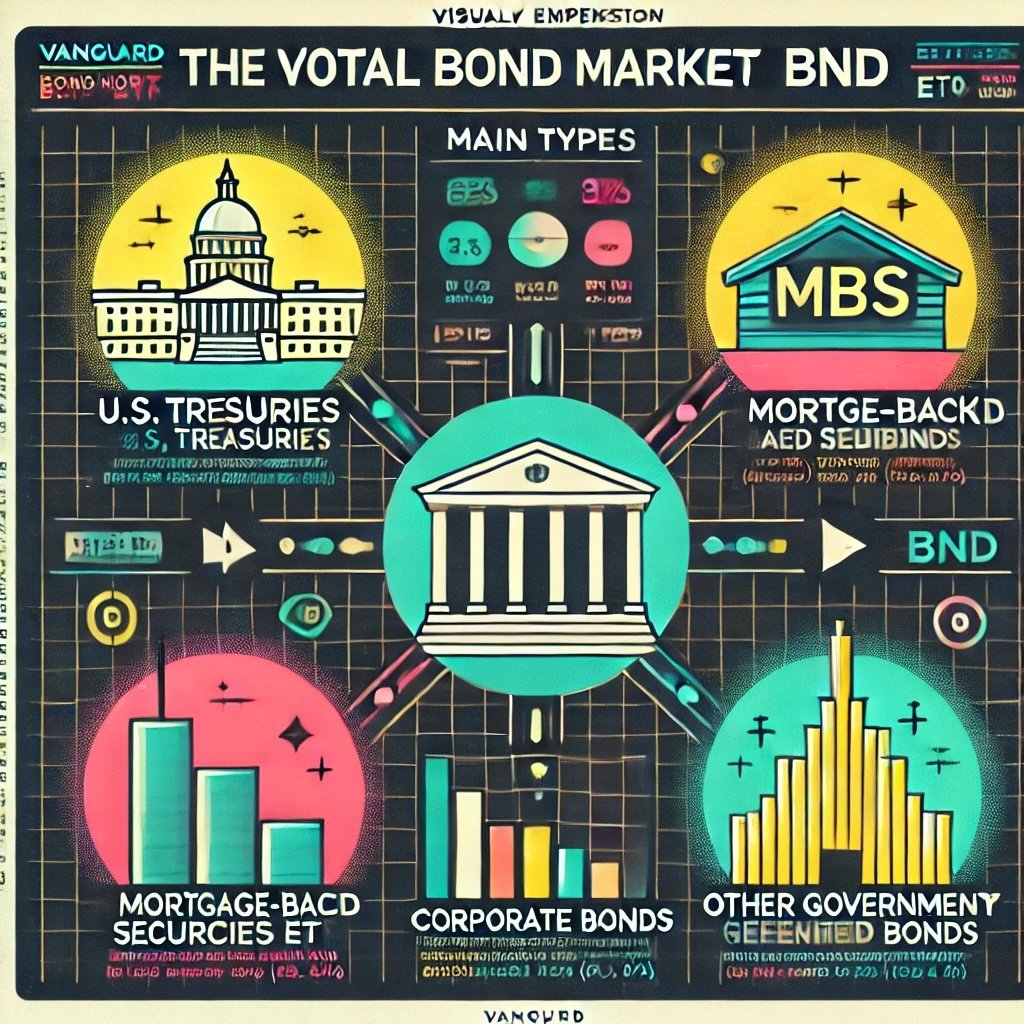
Composition of BND ETF
Types of Bonds Included
The Vanguard Total Bond Market ETF (BND) endeavors to capture the broad U.S. investment-grade bond universe. This means it pulls from:
- U.S. Treasuries: Typically low risk, these bonds are backed by the U.S. government’s full faith and credit. They serve as a foundational component, contributing heavily to BND’s overall stability.
- Mortgage-Backed Securities (MBS): Government-sponsored entities like Ginnie Mae, Fannie Mae, and Freddie Mac issue these securities. While slightly riskier than Treasuries, they’re still considered part of the core investment-grade space.
- Corporate Bonds: BND features a swath of corporate debt from highly rated (AAA to BBB) companies, spreading across different industries—financials, consumer, industrials, etc.
- Other Government-Related Bonds: Occasionally includes debt from local governments or agencies, though these typically constitute a smaller slice compared to Treasuries.
The result is a tapestry of thousands of bonds, each carrying its own coupon rate and maturity date, collectively offering a snapshot of America’s fixed-income market.
Credit Quality
One hallmark of BND is its focus on investment-grade bonds. This generally means the bonds carry ratings from agencies like Moody’s or S&P that land in the AAA to BBB range. Holdings that slip below BBB—known as high yield or “junk” bonds—are excluded. Consequently, BND’s credit risk remains moderate. You’re not banking on risky issuers with uncertain financial health.
If you examine BND’s credit distribution, you’ll likely find a significant chunk in AAA (representing Treasuries and top-tier corporates), then some in AA, A, and BBB categories. That said, the presence of BBB bonds can add some yield but also incremental risk. If macroeconomic conditions sour, those lower-tier investment-grade holdings might face potential downgrades. But that’s part of the broad-market approach: it doesn’t cherry-pick only the safest or highest-yield issues; it simply mirrors the index’s blend.
Maturity and Duration
Another vital aspect is the maturity profile of the bonds within BND. Being an aggregate bond index, it spans short-, intermediate-, and longer-dated securities. Typically, the weighted average maturity hovers around intermediate range (five to ten years). This positioning implies a certain duration—a measure of interest rate sensitivity. If interest rates spike, the price of bonds with longer duration can drop more significantly. So, owning BND means you’re exposed to some interest rate risk, as is common with broad bond funds.
Vanguard’s updates or prospectuses usually disclose the average effective duration, which might range from five to seven years. That’s moderate—less than some long-term government bond funds but higher than short-term or ultra-short bond ETFs. For many investors, this sweet spot captures a balance: high enough yield potential to justify holding bonds, but not so high that a small uptick in rates severely impairs prices.
Sector Allocation
On top of credit quality and maturity, it helps to consider sector allocation within BND. The largest slice typically belongs to U.S. Treasuries, given their outsized role in the overall bond market. Mortgage-backed securities follow close behind, reflecting the deep pool of mortgage finance in America. Corporate debt, ranging from finance to industrial to consumer staples, forms another significant wedge. This distribution rarely changes dramatically unless a major shift occurs in issuance patterns (e.g., corporations ramping up bond issues after a wave of low-interest opportunities).
This multi-sector approach mitigates the impact of slumps in any one area—like if corporate bonds stumble due to economic concerns, Treasuries might perform better in a flight-to-safety scenario, or vice versa. That synergy is the essence of a total bond market strategy: letting different bond categories offset each other’s weaknesses to maintain stable returns.
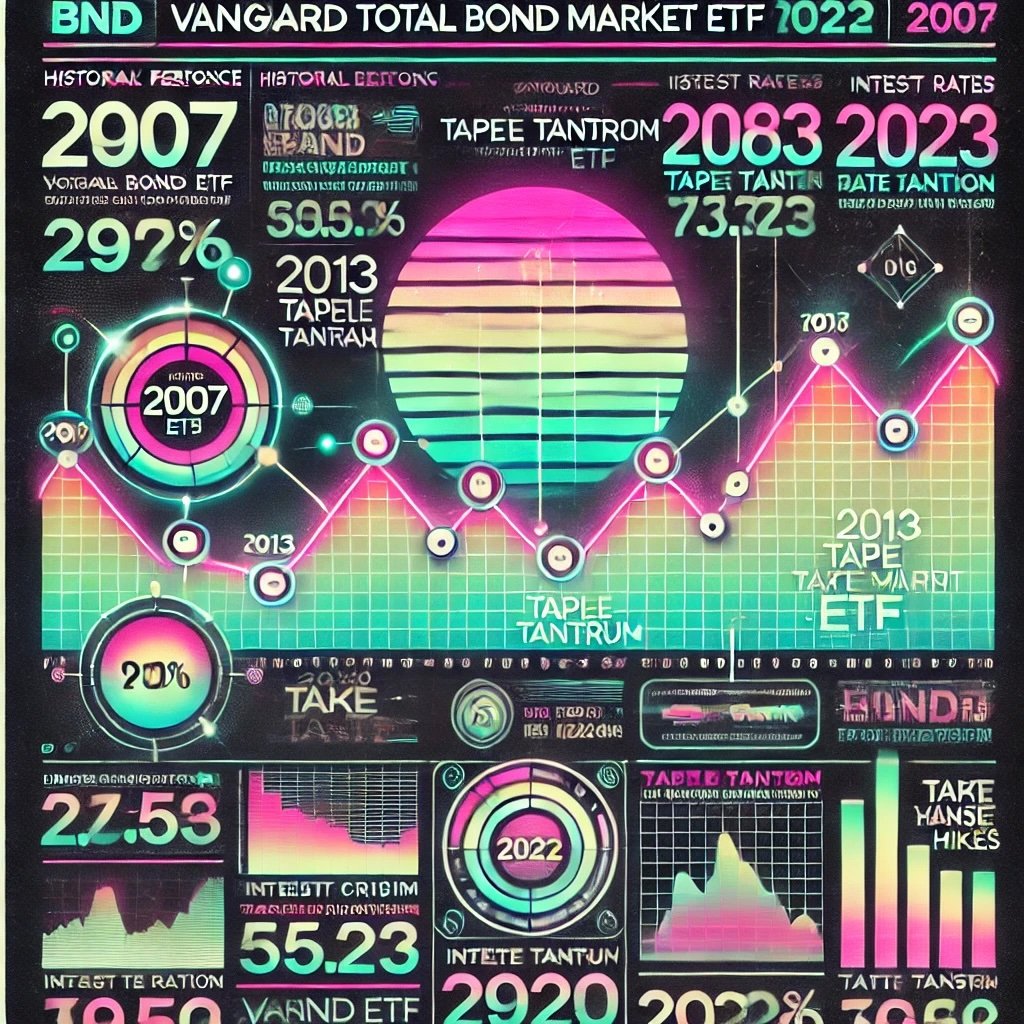
Historical Performance
Long-Term Trends
Assessing BND’s historical returns provides essential context for deciding whether it suits your investment goals. Since its inception in April 2007, BND has traversed economic peaks and valleys: the devastating 2008 financial crisis, the subsequent recovery, a long stretch of historically low interest rates, occasional rate hikes, and pandemic-driven volatility. During this span, its returns generally reflect the broader fixed-income environment—steady gains fueled by interest and price adjustments, though rarely dramatic peaks or troughs compared to equities.
Bond returns typically revolve around coupon payments plus any change in the bond’s price. In an extended bull run for bonds, fueled by falling rates, BND has historically delivered modest annualized returns. The yield has varied as the Federal Reserve toggled rates up or down, but overall, it’s consistent with a core U.S. aggregate bond strategy: conservative yet dependable growth.
Interest Rate Impact
A crucial determinant of bond performance is the interest rate climate. When rates drop, existing bonds with higher coupons become more valuable, boosting the ETF’s net asset value (NAV). By contrast, rising rates can undermine bond prices, prompting declines in NAV. BND, given its intermediate duration, feels the pinch when rates climb but usually weathers it better than long-term bond funds.
One instructive period was 2013’s “taper tantrum,” when the Federal Reserve hinted at reducing its quantitative easing. Rates rose abruptly, spooking bond markets. BND’s price took a mild hit that year, underscoring that it’s not immune to rate shifts. However, as rates later stabilized and yields recalibrated, BND recouped ground. Another example is the 2022 environment of accelerating rate hikes. BND experienced downward pressure on prices, as bond yields needed to realign with rising market rates.
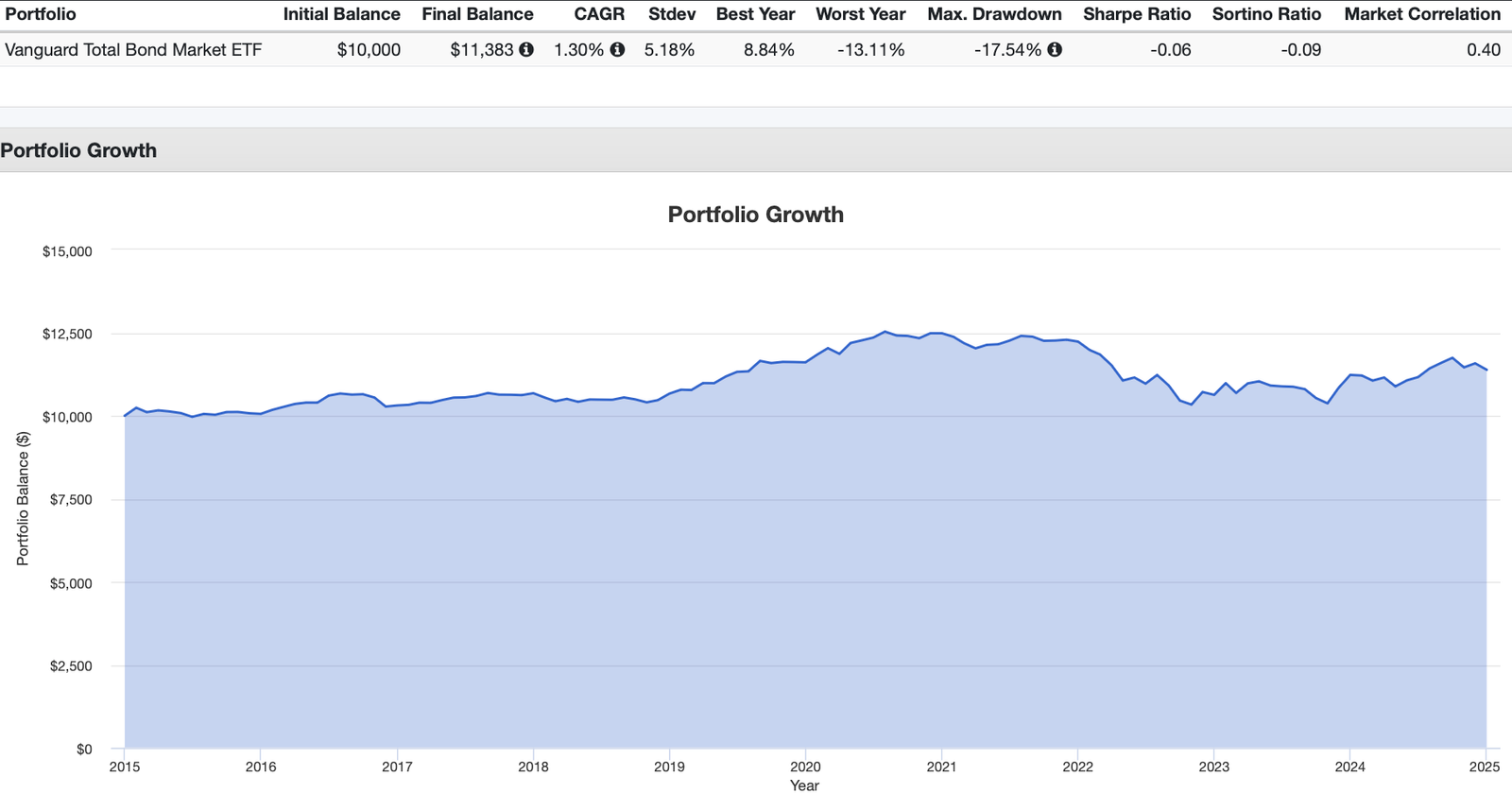
Comparing Benchmarks
BND is pegged to the Bloomberg U.S. Aggregate Float Adjusted Index, so you’d expect it to mirror that index closely. Relative to other broad-based bond funds, like the iShares Core U.S. Aggregate Bond ETF (AGG) or the Schwab U.S. Aggregate Bond ETF (SCHZ), performance differences are typically minuscule, often within fractions of a percentage point each year. The distinction often arises from small variations in expense ratios or the specific index methodology. But in essence, these funds produce quite similar trajectories.
Investors sometimes compare BND’s performance to that of more specialized bond funds—like those targeting high yields or emerging market debt. In buoyant markets, those funds might outdo BND, thanks to higher coupons. However, they also bear more volatility and default risk. BND aims for broad stability and moderate returns, reflecting the total market’s credit distribution minus junk. Over multiple cycles, it has typically delivered a balance of reasonable income and capital preservation.
Inflation and Returns
BND’s track record relative to inflation has varied. In low-inflation stretches, the real (inflation-adjusted) returns can be healthy enough to attract conservative savers. But in high-inflation scenarios—like the late 1970s or sporadic price surges in more recent times—bond yields sometimes lag behind inflation rates, eroding purchasing power. BND’s yield, being tethered to market interest rates, may not keep pace if inflation abruptly spikes and the Federal Reserve’s policy lags behind. This dynamic underscores that while BND is a valuable stabilizer, it’s not a cure-all in every economic scenario, especially during significant inflationary pressures.
Yet for many, BND’s overall track record remains compelling. It delivers consistent, if unspectacular, returns reflective of the broader bond environment, fulfilling its role as a “core” bond holding. After all, the main purpose of a total bond ETF is to reduce volatility and generate modest interest income, not to outrun equity markets or high-yield instruments.
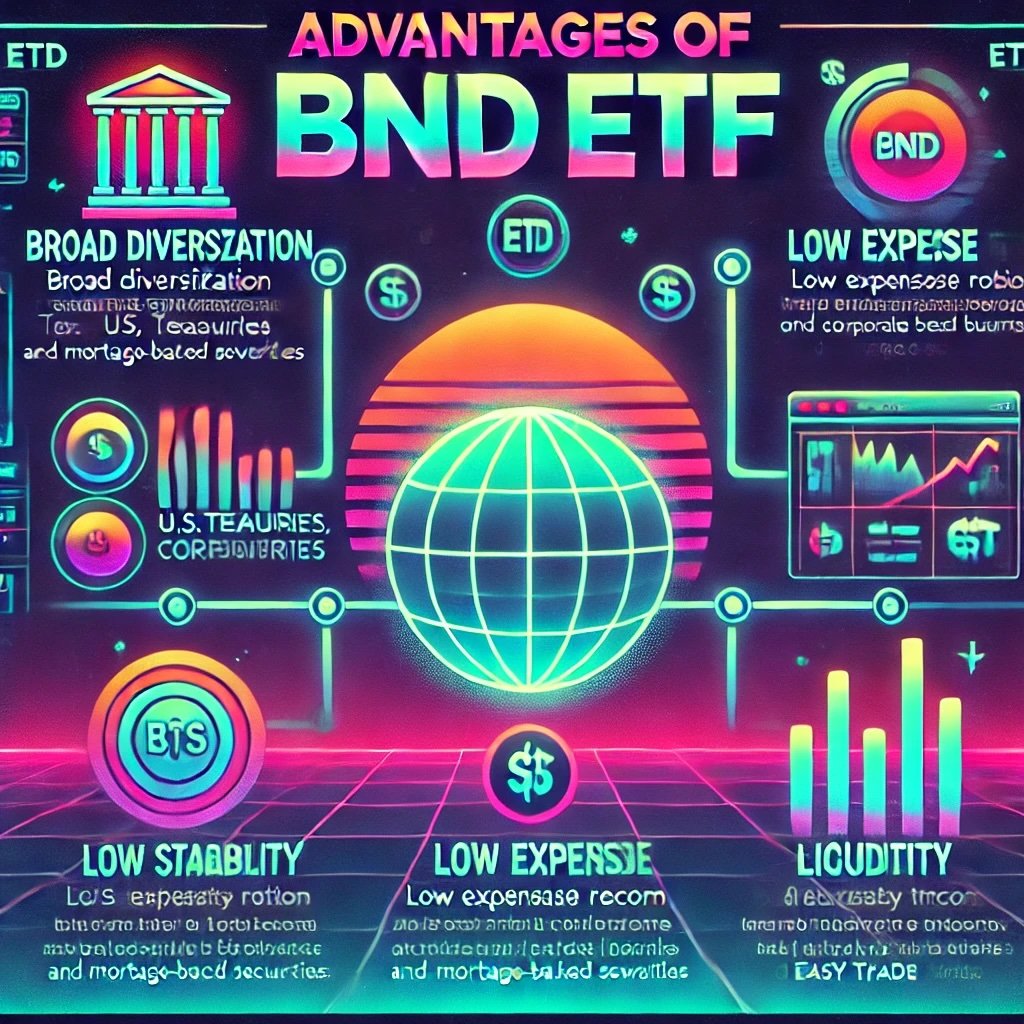
Advantages of BND ETF
If you’ve been following the conversation around low-cost index funds and the virtues of broad-market exposure, it’s no surprise that the Vanguard Total Bond Market ETF (BND) holds a prominent place. This section distills the most compelling benefits that lead investors to favor BND over alternative fixed-income strategies.
Broad Diversification
One of the most praised elements of BND is its coverage of the entire U.S. investment-grade bond spectrum. By owning a single ETF, you instantly acquire exposure to thousands of securities: U.S. Treasuries, mortgage-backed securities, and corporate bonds across multiple sectors. This breadth is akin to a built-in safety net. Even if a particular industry segment faces headwinds, the rest can help balance out overall returns.
For many retail investors, the prospect of researching and selecting individual bonds is daunting. BND sweeps away that complexity. It hands you a slice of each bond sector in proportion to its importance in the overall market, so you’re not inadvertently tilting your holdings too heavily toward a certain niche. That’s particularly beneficial if your bond allocation is meant to provide stability rather than speculative gains.
Low Expense Ratio
As part of Vanguard’s index-centric lineup, BND features a minuscule expense ratio—usually around 0.03% to 0.04%. In practical terms, this translates to paying $3 to $4 a year for every $10,000 invested. Such a small overhead ensures more of your interest income and price appreciation remains in your pocket instead of management’s coffers. Over extended periods, those percentage points matter immensely, especially given that bond returns can be more modest compared to equities. If you’re only expecting a certain yield, you don’t want fees chewing a substantial portion of it.
Stability and Predictable Income
BND aims to maintain an investment-grade credit profile. Most of its components come with relatively low default risk, especially the U.S. Treasuries and agency mortgage-backed securities that form a significant chunk. This focus on higher-grade bonds often results in a smoother ride compared to funds that dabble in high-yield or emerging market debt. You might still face interest rate volatility, but you’re less likely to suffer abrupt, issuer-specific downgrades that crater part of your portfolio.
Additionally, because of its mix of government and corporate debt, BND typically offers a modest but dependable stream of interest payments. Although the yield fluctuates alongside market rates, many retirees and conservative savers find reassurance in these predictable distributions. If your main objective is capital preservation plus moderate income, BND’s alignment with that vision is hard to ignore.
Liquidity and Accessibility
Another perk is that BND is an ETF, meaning you can buy and sell shares on the stock exchange throughout the trading day. In contrast, some bond mutual funds only permit end-of-day trades. This intraday liquidity can be advantageous if you need to adjust your allocation swiftly—though most fixed-income investors rarely engage in frantic trading. Still, liquidity equates to flexibility, even if you never fully exploit it.
Furthermore, because BND is so widely held and highly regarded, it usually features tight bid-ask spreads. You won’t typically lose too much in transaction costs when entering or exiting positions, which is often a concern for less popular bond ETFs or those focusing on niche markets.
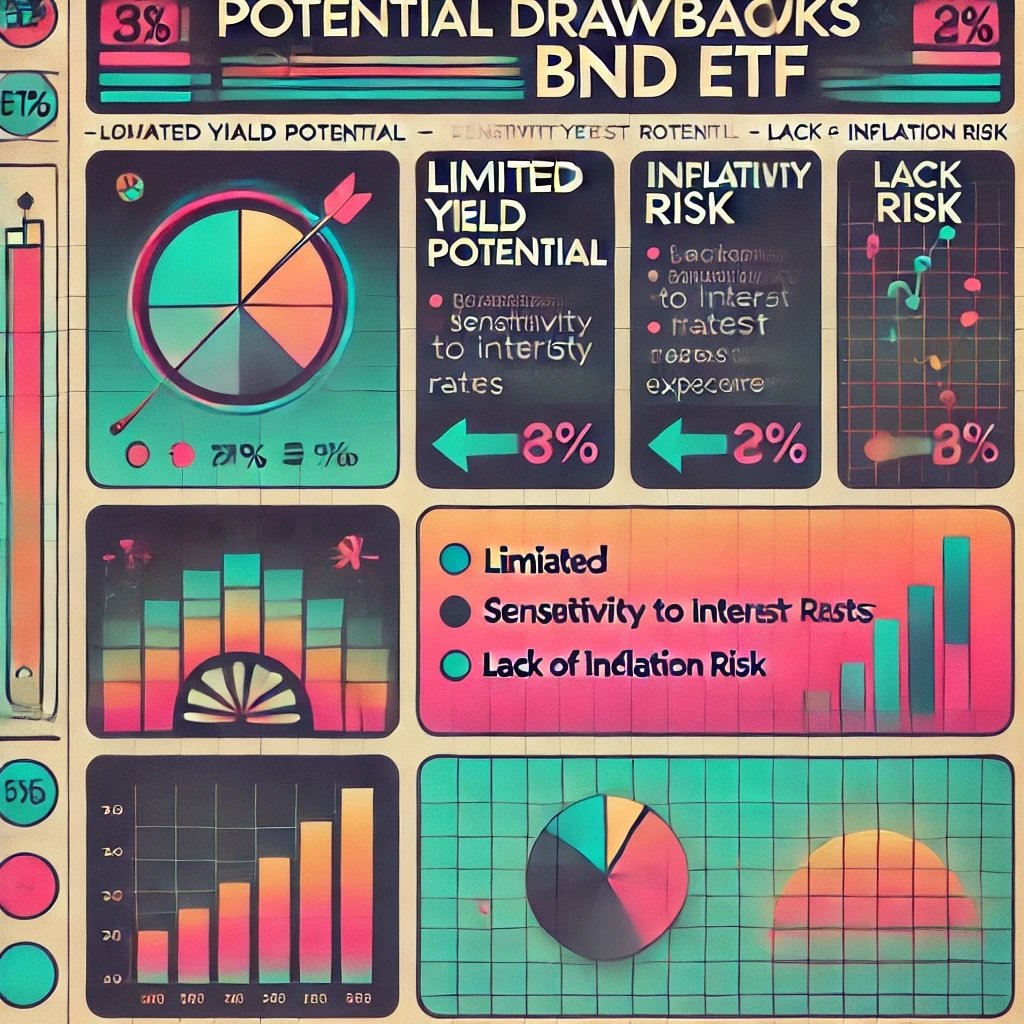
Potential Drawbacks of BND ETF
Even the most beloved funds, including the Vanguard Total Bond Market ETF (BND), have drawbacks. Recognizing these limitations can help you gauge how well BND fits into your unique financial landscape. Some shortfalls might be mere inconveniences, while others may steer you toward complementary or alternative investments.
Limited Yield Potential
One of the most conspicuous issues is that BND predominantly invests in investment-grade debt, prioritizing stability over yield. While that’s a boon for risk-averse investors, it also means BND’s payouts are modest in comparison to high-yield or “junk” bond funds. In a low-interest-rate environment, especially, the income from BND may barely outpace inflation. If your financial plan hinges on robust cash flow, BND’s yield might not cut it unless supplemented by other, higher-yielding assets.
Additionally, some might expect bond funds to consistently generate a certain level of interest. However, as interest rates shift, the coupon rates embedded in BND’s holdings adjust only when older bonds roll off and new ones come in. During periods of persistently low rates, the average yield can remain subdued for extended durations, limiting your income while you wait for the bond market to reset at more favorable rates.
Sensitivity to Interest Rates
All bond funds feel the ripple effects of interest rate movements, but a broad-based ETF like BND—carrying an intermediate duration—remains somewhat vulnerable to changes in the rate environment. When rates climb, especially rapidly, the market value of existing bonds typically declines, pulling down the fund’s net asset value. Although shorter-duration bond ETFs mitigate this effect, BND’s intermediate stance means it won’t be immune to rate spikes.
In practical terms, if the Federal Reserve hikes rates in a bid to combat inflation or stimulate economic adjustments, the prices of BND’s holdings can take a hit. Over time, that negative price move might be offset by newly added bonds sporting higher yields. However, it’s not a seamless transition. If you need to withdraw funds during a rising-rate period, you could realize losses on your shares, a scenario that might trouble those with shorter time horizons or limited risk appetite.
Inflation Risk
Fixed-income investments are always at the mercy of inflation, especially if yields are modest. If inflation surges and interest rates haven’t caught up, your real (inflation-adjusted) returns could turn negative. BND diversifies across government, mortgage, and corporate debt, but none of these sectors inherently protect you from inflation’s erosive force, aside from minor weighting in Treasury Inflation-Protected Securities (TIPS), if it holds any at all. If high inflation is your chief worry, you might consider pairing BND with TIPS-focused funds to shield your portfolio from severe inflationary episodes.
Lack of High-Yield Exposure
Given its broad coverage of investment-grade bonds, BND notably excludes high-yield debt. While many see that as a positive—protecting you from greater default risks—others might lament the missed opportunity for boosted income. A small allocation to junk bonds can sometimes enhance overall returns, particularly during stable or growth-oriented economic periods. BND’s mission is to mirror the investment-grade market, so it simply doesn’t tap the high-yield arena.
To address this gap, some investors supplement BND with a specialized high-yield bond ETF or prefer a different fund that integrates a portion of higher-risk, higher-yield credit. The trade-off, of course, is that you accept more volatility and potential default risk. For some, that’s a fair compromise to chase incremental yield.
![]()
Who Should Invest in BND ETF?
Selecting the right bond ETF often hinges on your broader investment goals and your stance on risk vs. reward. For the Vanguard Total Bond Market ETF (BND), let’s explore which kinds of investors typically embrace it and why, and also flag scenarios where it might not be a perfect match.
Conservative Investors
BND’s primary appeal is its investment-grade focus, which resonates strongly with conservative or risk-averse investors. If your principal aim is to safeguard capital and gain moderate interest income, BND’s diversified basket of Treasuries, mortgage-backed securities, and quality corporate debt offers a sense of security. While no bond fund can fully escape price dips if interest rates climb or credit markets sour, BND’s approach inherently seeks stability.
Retirees, for instance, often favor consistent, low-volatility returns over the roller-coaster ride of equities. By incorporating BND, they can anchor their portfolios, helping buffer the more dramatic fluctuations if they also hold equity ETFs. The monthly or quarterly distributions from BND can help supplement pension or Social Security income, though the yield, as noted earlier, may not be substantial in a low-rate environment.
Retirees or Income Seekers
Even if you’re not a conservative investor overall, you might still require a dependable income stream, particularly if you’re living off your portfolio. BND can serve that role effectively. Though the yield hovers at moderate levels, it’s relatively consistent and typically outperforms money market returns when rates are near historic norms. Some retirees implement a “core-satellite” strategy, using BND as the core holding and layering in a bit of high-yield or alternative bond funds for extra yield or diversification.
One caution for income seekers: if interest rates remain exceptionally low, BND’s distributions could feel underwhelming compared to your inflation-adjusted needs. In that case, consider mixing in other ETFs or strategies that can bolster yield, though at increased risk.
Portfolio Diversification
For those who rely heavily on stock investments—maybe a broad equity ETF like Vanguard’s VTI or an S&P 500 tracker—BND complements that exposure nicely. It can offset some of the equity volatility, thanks to the typical negative or low correlation between stock and bond returns during economic downturns. If you’re building a balanced portfolio, such as the classic 60/40 approach (60% stocks, 40% bonds), BND fits the bond side with minimal fuss.
Additionally, some younger or mid-career individuals might hold a chunk of their portfolio in equities but still want a stable portion in bonds to cushion large market swings or to preserve capital for near-term needs (like a down payment for a house in a few years). BND can be that calmer counterweight.
Limitations for Aggressive Investors
If your appetite for risk is higher, or you’re targeting significant capital appreciation, BND alone may feel too tame. It’s not designed to chase high yields or participate in niche, rapidly growing credit sectors. Those who crave more dynamic returns might explore corporate bond ETFs that venture into BBB- or even junk-rated territory, or specialized products focusing on emerging market debt. That route can offer more yield but with correspondingly higher default and market risks.
Similarly, if you have strong convictions about global investing, BND’s purely U.S.-centric approach might not cut it. You might prefer a global bond fund, or at least a separate international bond ETF, to round out your geographic diversification. Some experts argue that broad, international fixed-income exposure can enhance risk-adjusted returns, though exchange rate factors complicate the picture.
Summarizing Suitability
In short, BND typically appeals to those who value:
- Simplicity: One ETF for U.S. investment-grade bonds.
- Moderate Yield with Low Risk: Stability over chasing high returns.
- Cost-Effectiveness: A minimal expense ratio that doesn’t erode interest income.
- Diversification: An offset to equity volatility in a multi-asset portfolio.
In the often complex and jargon-laden world of bond investing, the Vanguard Total Bond Market ETF (BND) shines for its simplicity and breadth. It doesn’t promise to chase high yields through risky credit or bet on niche global corners. Rather, it aims to replicate, in a single stroke, the core of the U.S. investment-grade bond realm. If you’re seeking a no-nonsense foundation for your fixed-income allocation—one that merges Treasuries, mortgage-backed securities, and corporate bonds—BND stands as a compelling candidate.
So, who then is BND best suited for? Investors pursuing a balanced, buy-and-hold philosophy often find it an ideal anchor for their bond allocation. Retirees looking for a calmer ride, novices wanting a broad approach, or those searching for a straightforward hedge against equity volatility may all appreciate BND’s steady hand. Yet, if you thirst for higher income or aim to incorporate global or emerging market bonds, BND alone won’t suffice. In those cases, a more specialized or complementary product might prove necessary.
Ultimately, the Vanguard Total Bond Market ETF exemplifies the ease of index investing. You purchase one fund, gain exposure to a vast slice of the bond world, and pay minimal fees in the process. For many, that formula checks the key boxes of cost, diversification, and reliability. As you weigh how to integrate BND into your own strategy, keep in mind your unique risk tolerance, yield requirements, and time horizon. If those align well with BND’s attributes, you may discover it to be a cornerstone in your pursuit of financial stability and steady returns in the fixed-income realm.
BND ETF: 12-Question Expert FAQ for Vanguard Total Bond Market (Ticker: BND)
What index does BND track?
BND seeks to mirror the Bloomberg U.S. Aggregate Float Adjusted Index, covering U.S. dollar-denominated, investment-grade bonds (Treasuries, agency MBS/ABS, and corporate bonds).
How broad is BND’s bond market exposure?
Very broad for investment-grade U.S. bonds: it holds thousands of issues across government, mortgage-backed/asset-backed, and corporate sectors with varied maturities.
What’s BND’s typical duration and why does it matter?
BND usually sits in the intermediate range (roughly ~5–7 years). Intermediate duration means moderate interest-rate sensitivity: rising rates can push prices down; falling rates can lift them.
How often does BND pay income and what’s the yield like?
Distributions are paid monthly. The yield floats with market rates and the mix of bonds in the index. Bond yields can lag inflation during high-inflation periods.
Is BND tax-efficient in a taxable account?
ETFs are generally tax-efficient due to in-kind redemptions and low turnover. That said, ordinary bond income is typically taxed at ordinary rates—your personal situation drives outcomes.
How does BND compare with AGG and SCHZ?
All three are low-cost, U.S. “Agg” trackers with nearly identical mandates. Long-run performance differences are usually tiny and reflect fee and index-methodology nuances.
Does BND include high yield (“junk”) bonds?
No. BND is investment-grade only (AAA to BBB). If you need more income and accept higher risk, a separate high-yield sleeve is required.
What role can BND play in a portfolio?
It’s a classic “core bond” anchor: dampens equity volatility, provides diversification, and supplies steady income. Common in 60/40 or core-satellite allocations.
What are the main risks of BND?
Interest-rate risk (prices fall when rates rise), inflation risk (real returns can be pressured when inflation runs hot), and credit spread risk (corporates can widen during stress).
How is BND’s sector mix typically distributed?
Heavily in Treasuries and agency MBS, with a meaningful corporate sleeve. This blend helps balance “flight-to-quality” behavior (Treasuries) against credit-driven income (corporates).
Who might prefer alternatives to BND?
Investors seeking higher yield (high yield, EM debt), inflation hedging (TIPS funds), shorter interest-rate exposure (short-term bond ETFs), or global diversification (international bond funds).
Any best-practice tips for using BND?
Match your bond sleeve to goals: pair BND with TIPS for inflation defense, with short-term bonds to cut rate sensitivity, or with international bonds for broader diversification. Rebalance periodically. (General information, not investment advice.)
Important Information
Comprehensive Investment Disclaimer:
All content provided on this website (including but not limited to portfolio ideas, fund analyses, investment strategies, commentary on market conditions, and discussions regarding leverage) is strictly for educational, informational, and illustrative purposes only. The information does not constitute financial, investment, tax, accounting, or legal advice. Opinions, strategies, and ideas presented herein represent personal perspectives, are based on independent research and publicly available information, and do not necessarily reflect the views or official positions of any third-party organizations, institutions, or affiliates.
Investing in financial markets inherently carries substantial risks, including but not limited to market volatility, economic uncertainties, geopolitical developments, and liquidity risks. You must be fully aware that there is always the potential for partial or total loss of your principal investment. Additionally, the use of leverage or leveraged financial products significantly increases risk exposure by amplifying both potential gains and potential losses, and thus is not appropriate or advisable for all investors. Using leverage may result in losing more than your initial invested capital, incurring margin calls, experiencing substantial interest costs, or suffering severe financial distress.
Past performance indicators, including historical data, backtesting results, and hypothetical scenarios, should never be viewed as guarantees or reliable predictions of future performance. Any examples provided are purely hypothetical and intended only for illustration purposes. Performance benchmarks, such as market indexes mentioned on this site, are theoretical and are not directly investable. While diligent efforts are made to provide accurate and current information, “Picture Perfect Portfolios” does not warrant, represent, or guarantee the accuracy, completeness, or timeliness of any information provided. Errors, inaccuracies, or outdated information may exist.
Users of this website are strongly encouraged to independently verify all information, conduct comprehensive research and due diligence, and engage with qualified financial, investment, tax, or legal professionals before making any investment or financial decisions. The responsibility for making informed investment decisions rests entirely with the individual. “Picture Perfect Portfolios” explicitly disclaims all liability for any direct, indirect, incidental, special, consequential, or other losses or damages incurred, financial or otherwise, arising out of reliance upon, or use of, any content or information presented on this website.
By accessing, reading, and utilizing the content on this website, you expressly acknowledge, understand, accept, and agree to abide by these terms and conditions. Please consult the full and detailed disclaimer available elsewhere on this website for further clarification and additional important disclosures. Read the complete disclaimer here.




